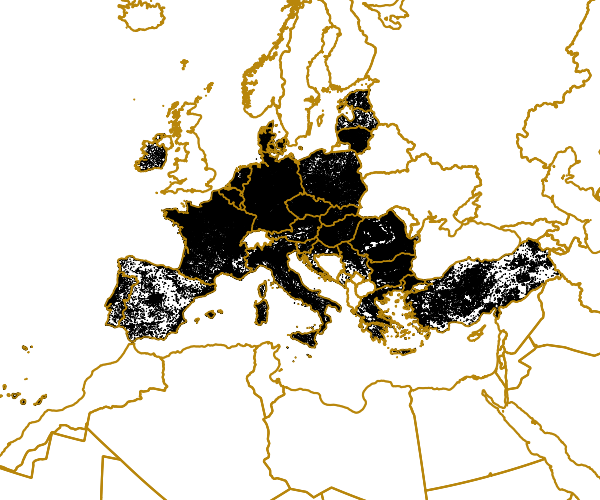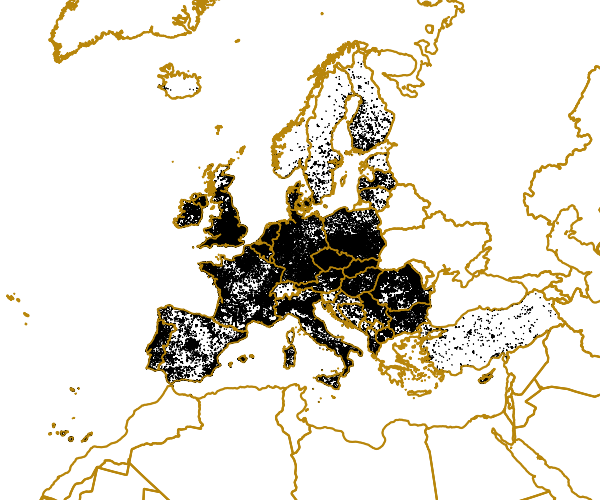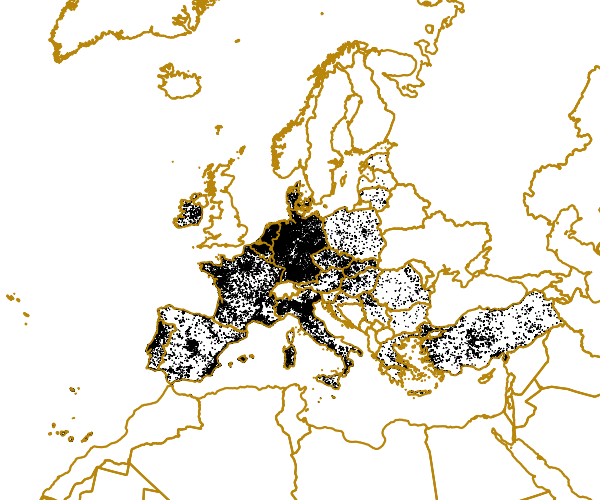urban environment, urban stress
Type of resources
Available actions
Topics
INSPIRE themes
Keywords
Contact for the resource
Provided by
Years
Formats
Representation types
Update frequencies
Scale
Resolution
-

An urban morphological zone (UMZ) is defined as a "set of urban areas laying less than 200 m apart". This layer contains UMZ delineations for Europe, based on Corine Land Cover database. During 2012, the UMZ methodology was updated in order to correct errors derived for the water course as join elements between urban areas. Previous version applied over CLC v15 (and previous version) joined many small urban areas due to the water presence. This fact was erroneous from the landscape and urban perspective as most of those areas remain as urban-rural typologies. Moreover, water courses cannot be considered as roads from the urban morphological view (either from the commuting point of understanding). This new version, known as v16, corrected this effect in the majority of cases.
-

An urban morphological zone (UMZ) is defined as a "set of urban areas laying less than 200 m apart". This layer contains UMZ delineations for Europe, based on Corine Land Cover database. During 2012, the UMZ methodology was updated in order to correct errors derived for the water course as join elements between urban areas. Previous version applied over CLC v15 (and previous version) joined many small urban areas due to the water presence. This fact was erroneous from the landscape and urban perspective as most of those areas remain as urban-rural typologies. Moreover, water courses cannot be considered as roads from the urban morphological view (either from the commuting point of understanding). This new version, known as v16, corrected this effect in the majority of cases.
-

The raster dataset of urban heat island modelling shows the fine-scale (100m pixel size) temperature differences (in degrees Celsius °C) across 100 European cities, depending on the land use, soil sealing, anthropogenic heat flux, vegetation index and climatic variables such as wind speed and incoming solar radiation. In the framework of the Copernicus European Health contract for the Copernicus Climate Change Service (C3S), VITO provided 100m resolution hourly temperature data (2008-2017) for 100 European cities, based on simulations with the urban climate model UrbClim (De Ridder et al., 2015). As the cities vary in size, so do the model domains. They have been defined with the intention to have a more or less constant ratio of urban vs. non-urban pixels (as defined in the CORINE land use map), with a maximum of 400 by 400 pixels (due to computational restraints). From this data set, the average urban heat island intensity is mapped for the summer season (JJA), which is the standard way of working in the scientific literature (e.g. Dosio, 2016). The UHI is calculated by subtracting the rural (non-water) spatial P10 temperature value from the average temperature map. The 100 European cities for the urban simulations were selected based on user requirements within the health community.
-

This raster dataset provides the modelling of the climate suitability index values (0-100%) for tiger mosquito (Aedes albopictus) for 100 European cities for the years 2008-2009, with a resolution of 100 m. Aedes Albopictus has become a common occurrence in Southern Europe and transmits diseases such as Zika, dengue and chikungunya. The climatic suitability for tiger mosquito depends on factors such as sufficient amounts of rainfall, high summer temperatures and mild winters. Climate change is anticipated to further facilitate the spread of tiger mosquitoes across Europe by changing temperature and precipitation patterns, thereby increasing the suitable habitat. In the framework of the Copernicus Climate Change Service (C3S) SIS European Health, VITO has provided to the Climate Data Store 100m resolution hourly temperature data for 100 European cities, based on simulations with the urban climate model UrbClim (De Ridder et al., 2015). From this dataset, this climate suitability dataset has been generated based on annual precipitation and the average temperature in January and during the summer period (months June, July and August) for the years 2008-2009, following the methodology by European Centre for Disease Prevention and Control (ECDC, 2009). The 100 European cities for the urban simulations were selected based on user requirements within the health community.
-

An urban morphological zone (UMZ) is defined as a "set of urban areas laying less than 200 m apart". This layer contains UMZ delineations for Europe, based on Corine Land Cover database. During 2012, the UMZ methodology was updated in order to correct errors derived for the water course as join elements between urban areas. Previous version applied over CLC v15 (and previous version) joined many small urban areas due to the water presence. This fact was erroneous from the landscape and urban perspective as most of those areas remain as urban-rural typologies. Moreover, water courses cannot be considered as roads from the urban morphological view (either from the commuting point of understanding). This new version, known as v16, corrected this effect in the majority of cases.
-

Changes between UMZs in 2000 and UMZs in 2006 using CLC version 16. Most changes are Positive changes, understood as areas of urban sprawl (i.e. new UMZ areas between 2000 and 2006), while negative changes describe the reduction of a certain UMZ between 2000 and 2006 (warning: some negative changes might be due to different interpretations between 2000-2006).
-

Changes between UMZs in 1990 and UMZs in 2000 using CLC version 16. Most changes are Positive changes, understood as areas of urban sprawl (i.e. new UMZ areas between 1990 and 2000), while negative changes describe the reduction of a certain UMZ between 1990 and 2000 (warning: some negative changes might be due to different interpretations between 1990-2000).
-

This vector dataset provides the climate suitability index values (0-100%) for tiger mosquito (Aedes albopictus) for 100 European cities for the years 2008-2009 (P90 - 90th percentile). Aedes Albopictus has become a common occurrence in Southern Europe and transmits diseases such as Zika, dengue and chikungunya. The climatic suitability for tiger mosquito depends on factors such as sufficient amounts of rainfall, high summer temperatures and mild winters. Climate change is anticipated to further facilitate the spread of tiger mosquitoes across Europe by changing temperature and precipitation patterns, thereby increasing the suitable habitat. In the framework of the Copernicus Climate Change Service (C3S) SIS European Health, VITO has provided to the Climate Data Store 100m resolution hourly temperature data for 100 European cities, based on simulations with the urban climate model UrbClim (De Ridder et al., 2015). From this dataset, this climate suitability dataset has been generated based on annual precipitation and the average temperature in January and during the summer period (months June, July and August) for the years 2008-2009, following the methodology by European Centre for Disease Prevention and Control (ECDC, 2009). This approach considers empirical suitability functions, which link a number of (aggregated) climate variables to the suitability of a habitat for a given vector species, e.g. for a species to be active a minimum threshold of temperature is required below which the species is not active. Similarly some species cannot overwinter if the winter is too cold (e.g. January temperature lower than a given value). The P90 indicator represents the specific exposure of single cities and is independent of the model domain or size of a city. The 100 European cities for the urban simulations were selected based on user requirements within the health community.
-

This vector dataset shows the Urban Heat Island (UHI) intensity (in degrees Celsius °C) for 100 European cities, based on their elevation above sea level, land use, soil sealing, vegetation index and anthropogenic heat flux. The Urban Heat Island intensity exacerbates high temperatures in cities and thus may pose additional risks to human thermal comfort and health. The UHI intensity is represented by spatial P90 (90th percentile) urban heat island intensity of a given city ("P90" field in the dataset). This indicator is calculated by subtracting the rural (non-water) spatial P10 (10th percentile) temperature value from the average, height-corrected (to exclude terrain effects), air temperature map. This indicator represents the specific exposure of single cities and due to the height correction will be comparable across Europe. The dataset has been created by VITO within the Copernicus Health contract for C3S and is based on UrbClim model (De Ridder et al. 2015). The 100 European cities for the urban simulations were selected based on user requirements within the health community.
 RUC Geo-Data catalogue
RUC Geo-Data catalogue